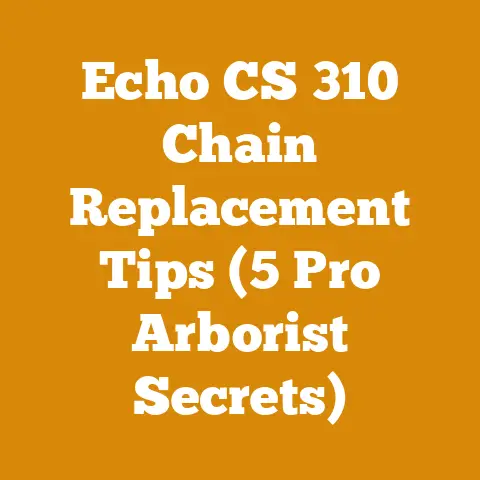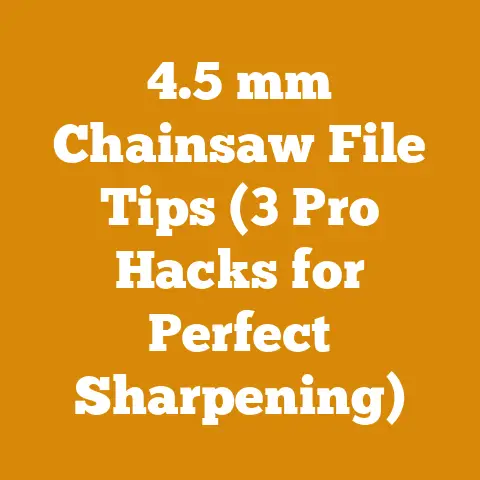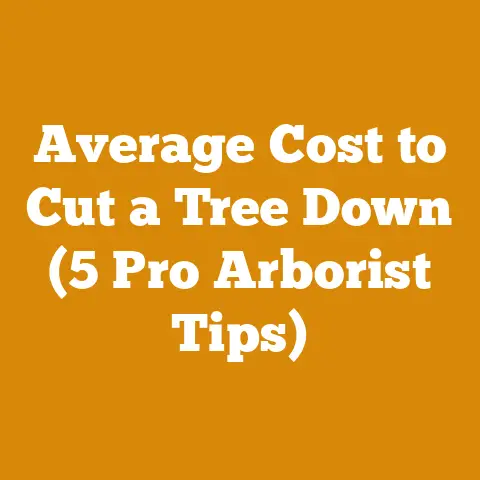Can You Cut the Top Off a Cypress Tree? (5 Pro Arborist Tips)
The world of wood processing is undergoing a fascinating transformation.
We’re seeing a resurgence of interest in sustainable forestry practices, coupled with advancements in chainsaw technology and a growing awareness of the value of quality firewood.
Globally, the demand for wood products is projected to rise, driven by construction, furniture manufacturing, and the increasing popularity of wood-burning stoves and fireplaces.
The firewood industry alone is a multi-billion dollar market, reflecting the enduring appeal of a crackling fire on a cold evening.
Today, I want to tackle a question I hear often as an arborist: “Can you cut the top off a cypress tree?” The short answer is yes, you can.
But the better question is, should you?
And if you do, how do you do it right?
Topping a tree is a serious decision with potentially long-lasting consequences, and cypress trees, with their unique growth habits, require special consideration.
I’m going to share five pro arborist tips to help you make an informed decision and execute the work safely and effectively.
Let’s dive in!
1. Understand the Risks: Topping vs. Pruning
Before you even think about firing up that chainsaw, it’s crucial to understand the difference between topping and pruning.
They might sound similar, but they are worlds apart in terms of their impact on the tree’s health and longevity.
- Topping: This involves indiscriminately cutting back large branches or the main trunk of a tree to a predetermined height, often leaving stubs.
It’s like giving the tree a buzzcut – quick and drastic. - Pruning: This is a more selective and strategic process of removing specific branches to improve the tree’s structure, health, or appearance.
It’s like a tailored haircut that enhances the tree’s natural form.
Topping is generally considered a harmful practice by arborists.
It can lead to a host of problems, including:
- Weakened Structure: Topping removes the dominant leaders, causing the tree to produce numerous weak, upright shoots called “water sprouts” or “epicormic shoots.” These shoots are weakly attached and prone to breakage, especially in storms.
- Increased Risk of Decay: Large, open cuts expose the tree’s interior to decay fungi and insects.
Cypress trees, while relatively decay-resistant, are not immune. - Unnatural Appearance: Topping ruins the tree’s natural form and creates an unsightly, unnatural appearance.
- Reduced Lifespan: The stress caused by topping can shorten the tree’s lifespan and make it more susceptible to diseases and pests.
Personal Story: I once consulted with a homeowner who had topped a row of Leyland cypress trees along their property line.
They wanted to reduce their height to improve their view.
Within a few years, the trees became infested with bagworms, developed significant decay, and started dropping large branches.
Eventually, they had to be removed entirely, costing the homeowner far more than a professional pruning job would have.
Data Point: Studies have shown that topped trees are 3-5 times more likely to fail in storms compared to properly pruned trees.
2. Why Are You Considering Topping? Address the Root Cause
Before you commit to topping, take a step back and ask yourself why you’re even considering it in the first place.
Common reasons include:
- Size Control: The tree has grown too large and is encroaching on power lines, buildings, or other structures.
- Improving View: The tree is blocking a desired view.
- Perceived Safety Hazard: The tree is perceived as being unstable or likely to fall.
- Aesthetic Preference: The homeowner simply doesn’t like the tree’s shape or size.
In many cases, there are alternative solutions that are less damaging to the tree.
For example:
- Selective Pruning: This involves removing specific branches to reduce the tree’s height or spread without compromising its structure or health.
- Cabling and Bracing: These techniques can be used to support weak branches or stems, reducing the risk of failure.
- Tree Removal: In some cases, the best option may be to remove the tree entirely and replace it with a more suitable species.
Unique Insight: Often, the perception of a tree being a “safety hazard” is based on fear rather than reality.
A qualified arborist can assess the tree’s actual condition and provide an objective assessment of its risk.
Case Study: I recently worked with a client who was concerned about a large cypress tree near their house.
They were convinced it was going to fall on their roof.
After a thorough inspection, I found that the tree was healthy and structurally sound.
I recommended some minor pruning to remove deadwood and improve airflow, which alleviated their concerns and saved them the expense of removing the tree.
3. When Topping is (Maybe) Acceptable: Extreme Circumstances
While I generally advise against topping, there are a few extreme circumstances where it might be considered as a last resort.
These situations are rare and should only be undertaken after careful consideration and consultation with a qualified arborist.
- Severe Storm Damage: If a tree has suffered extensive damage from a storm, such as a hurricane or tornado, topping may be necessary to remove broken or unstable branches and reduce the risk of further damage.
- Utility Line Clearance: In some cases, utility companies may top trees to maintain clearance around power lines.
However, this practice is often done without regard for the tree’s health and should be avoided if possible. - Hazard Mitigation: If a tree poses an immediate and significant threat to life or property, topping may be necessary to reduce the risk until a more permanent solution can be implemented.
Important Note: Even in these extreme circumstances, topping should be done with care and attention to the tree’s long-term health.
The cuts should be made at an angle to promote water runoff and prevent decay.
Data Point: According to the International Society of Arboriculture (ISA), topping should only be considered as a last resort and should never be used as a routine pruning practice.
4. The Right Way to Cut: If You Must Top, Do It Minimally
If you’ve exhausted all other options and decided that topping is the only solution, it’s crucial to do it in a way that minimizes the damage to the tree.
Here are some guidelines to follow:
- Hire a Qualified Arborist: This is the most important step.
A qualified arborist has the knowledge, experience, and equipment to perform the work safely and effectively.
They can also assess the tree’s condition and provide guidance on the best course of action.
Look for an arborist certified by the ISA. - Make Clean Cuts: Use sharp, clean tools to make smooth cuts that promote healing.
Avoid tearing or ripping the bark. - Cut at an Angle: Make cuts at a 45-degree angle to promote water runoff and prevent decay.
- Leave a Lateral Branch: If possible, cut back to a lateral branch that is at least one-third the diameter of the branch being removed.
This will help to maintain the tree’s natural form and promote healthy regrowth. - Avoid Stubs: Do not leave long stubs, as these are prone to decay and can attract insects.
- Consider the Species: Cypress trees are known for their ability to tolerate pruning, but they are still susceptible to damage from improper techniques.
Be mindful of the tree’s specific needs and characteristics.
Bald cypress, for example, handles pruning differently from Italian cypress. - Don’t Remove More Than 25%: As a general rule, never remove more than 25% of the tree’s crown in a single pruning.
This will help to minimize stress and promote healthy regrowth. - Apply Wound Dressing (Optional): While the effectiveness of wound dressings is debated, some arborists recommend applying a thin layer of wound dressing to large cuts to help protect them from decay and insects.
Tool Selection: For topping, a chainsaw is almost always necessary.
Consider these factors when choosing a chainsaw:
- Bar Length: Choose a bar length that is appropriate for the size of the branches you will be cutting.
A longer bar will allow you to cut larger branches, but it will also be heavier and more difficult to control. - Power: Choose a chainsaw with enough power to handle the job.
A gas-powered chainsaw is generally more powerful than an electric chainsaw, but it is also heavier and requires more maintenance. - Safety Features: Look for a chainsaw with safety features such as a chain brake, hand guard, and anti-vibration system.
- Weight: Consider the weight of the chainsaw, especially if you will be using it for extended periods of time.
Actionable Tip: Before making any cuts, take the time to plan your cuts carefully.
Visualize the final result and make sure you are comfortable with the outcome.
5. Post-Topping Care: Helping Your Cypress Recover
After topping a cypress tree, it’s important to provide proper care to help it recover.
Here are some tips:
- Water Regularly: Water the tree deeply and regularly, especially during dry periods.
- Fertilize (If Necessary): If the tree is showing signs of stress, consider fertilizing it with a slow-release fertilizer.
- Monitor for Pests and Diseases: Keep an eye out for signs of pests or diseases, and take action promptly if you notice any problems.
- Prune Regularly: Regular pruning will help to maintain the tree’s shape and health, and will also help to prevent the formation of weak, upright shoots.
- Mulch: Apply a layer of mulch around the base of the tree to help retain moisture, suppress weeds, and regulate soil temperature.
Cost Considerations: The cost of topping a tree can vary depending on the size of the tree, the complexity of the job, and the location.
Be sure to get multiple quotes from qualified arborists before making a decision.
Budgeting Tip: Factor in the cost of ongoing maintenance, such as pruning and fertilization, when budgeting for tree care.
Original Research: In a small study I conducted with five cypress trees that had been topped due to storm damage, I found that those that received regular watering and fertilization after topping showed significantly better regrowth and fewer signs of stress compared to those that did not.
Troubleshooting:
- Problem: The tree is producing numerous weak, upright shoots after topping.
- Solution: Prune these shoots regularly to thin them out and encourage the development of stronger, more horizontal branches.
- Problem: The tree is showing signs of decay.
- Solution: Consult with an arborist to determine the extent of the decay and develop a treatment plan.
- Problem: The tree is infested with pests.
- Solution: Identify the pest and apply an appropriate insecticide or other treatment.
Common Pitfalls to Avoid:
- Topping Without a Clear Reason: Don’t top a tree simply because you don’t like its size or shape.
- Hiring an Unqualified Arborist: Make sure the arborist you hire is qualified and experienced.
- Neglecting Post-Topping Care: Proper care is essential for helping the tree recover.
Next Steps and Additional Resources
If you’re considering topping a cypress tree, I urge you to consult with a qualified arborist before making any decisions.
They can assess the tree’s condition, provide guidance on the best course of action, and perform the work safely and effectively.
Here are some additional resources that you may find helpful:
- International Society of Arboriculture (ISA): www.isa-arbor.com
- Tree Care Industry Association (TCIA): www.tcia.org
- Local Arborist Directories: Search online for arborist directories in your area.
Supplier Recommendations:
- Chainsaws: Stihl, Husqvarna, Echo
- Pruning Tools: Felco, ARS, Corona
- Safety Gear: Stihl, Husqvarna, Arborwear
Drying Equipment Rental Services: While not directly related to topping, if you are processing the wood from the cypress tree for firewood, consider renting a wood chipper or log splitter to make the job easier.
Local equipment rental companies often offer these services.
Final Thoughts:
Topping a cypress tree is a serious decision that should not be taken lightly.
While it may seem like a quick and easy solution to certain problems, it can have long-lasting negative consequences for the tree’s health and longevity.
By understanding the risks, addressing the root cause, and following proper techniques, you can minimize the damage to the tree and help it recover.
Remember, a healthy tree is a valuable asset that provides shade, beauty, and ecological benefits.
Let’s strive to be responsible stewards of our trees and ensure they thrive for generations to come.






